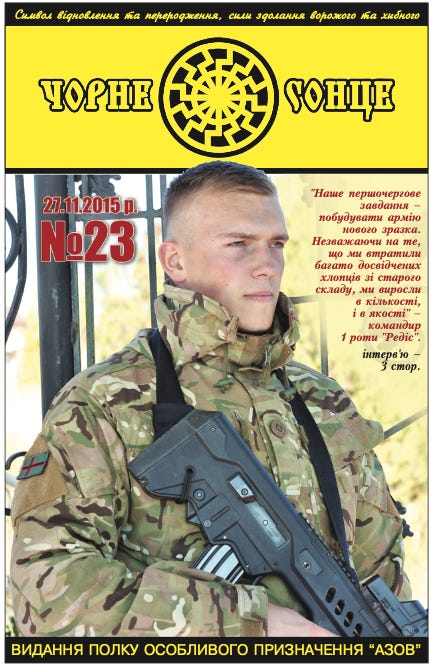News Highlight 3/9: Azov, Humanitarianism, and No-Fly Zones
Since this is the first of what I hope to be an ongoing series, I think it is important to specify what these highlights will and wont be.
Firstly, I will avoid reprinting and summarizing first page news stories. Information about the general thrust of the war on any particular day is easy to come by. I will also avoid referencing opinion pieces that simply restate the claims and arguments of the US State Department. Finding information on the official stances of the US government and its allies is also quite simple.
What these newsletters will do is attempt to highlight news, stories, and perspectives that provide the vital context often lacking in feverish war coverage by the Western press. It will seek out stories that have been generally obscured, overlooked, or ignored. It will attempt to be a counterweight, however small, to the prevailing pro-war narratives so easily offered in these chaotic times.
That said, here we go:
Azov Regiment Commander Calls for “No-Fly Zone” Over Ukraine
The head of the Azov regiment, a formerly paramilitary group now officially incorporated into the Ukrainian National Guard, has called for the world community to institute a no-fly zone over Ukraine. Major Denys Prokopenko’s ambitious request was due to apparent concern for the humanitarian situation in Mariupol, as the attempted “humanitarian corridor” broke down amid claims of shelling from both sides.
According to Prokopenko, the only way to ensure the supply of food, water, and medicine is to institute a no-fly zone over Ukraine, a call which President Zelenskyy has echoed repeatedly. A no-fly zone, in theory, would forbid Russian planes from entering Ukrainian airspace in an attempt to limit Russian air-strikes and curb civilian casualties. Enforcement of a no fly zone would entail constant monitoring of the skies within Ukraine’s borders and, in the event of Russian non-compliance, the threat of directly attacking Russian planes. If a no-fly zone is established by NATO, this would also entail a direct confrontation between NATO and Russian forces, and the potential escalation to a hot conflict between a nuclear state and an alliance of nuclear states. Additionally, in the event that Russia attacks a NATO force patrolling or enforcing the no-fly zone, it could trigger Article 5 of the NATO treaty, in which “an attack against one Ally is considered as an attack against all Allies.” In this scenario most of Western Europe would be officially at war with Russia.
Major Prokopenko’s insistence on the implementation of a no-fly zone for humanitarian reasons sits at odds with his regiment’s history of human rights violations and violent, fascist ideology. The Maidan Revolution of 2014, ousted the (fairly) Russian-friendly President Viktor Yanukovich, and installed the nationalist, Western-friendly, right-wing Petro Poroshenko. Immediately after Maidan, the deeply Russophobic Azov Battalion was officially incorporated into the Ukrainian National Guard. They have since been accused of kidnapping and torture in Eastern Ukraine during operations in and around the Russian-backed separatist regions in the Donbas (in coordination with Ukraine’s Security Services), targeting civilians, coordinating violence against Ukraine’s Roma population, attacking LGBTQ groups, terrorizing a municipal council meeting, greasing bullets with pig fat for Muslim troops, and general unchecked vigilantism.
Major Prokopenko himself first appeared on the English language media scene as a background character in the viral story of AK-47-wielding Ukrainian grandma Valentyna Konstantynovska who was training with Azov to defend her homeland from Russian invaders. According to investigative reporter Oleksiy Kuzmenko, Prokopenko has been with the Azov Battallion since its 2014 and throughout its violent post-Maidan rise to power and legal incorporation. Prokopenko, like many European ultra-nationalists, got his start in a football hooligan group supporting Dynamo Kyiv. In 2015 he was featured on the cover of the Azov Regiment’s magazine “Black Sun” (a reference to the Nazi Sonnenrad symbol sported by many Azov fighters).
In a March 3rd interview this year, Prokopenko claimed that this Nazi iconography was the reason that the Azov Regiment has been denied humanitarian aid, weapons, or training from the Western nations. This, however, conflicts with reporting that Azov members have, in fact, been training in Canada and other NATO countries, recruiting Western white supremacists, and receiving military aid (despite feeble efforts to ensure US weapons don’t fall into Nazi hands). Just yesterday, the Azov Regiment was pictured alongside a brand new shipment of NLAW anti-tank grenade launchers presented by NATO instructors.
As Biden earmarks $13.6 billion dollars in aid to Ukraine it seems reasonable to expect that Major Prokopenko’s regiment will continue to benefit from the flow of Western weapons and aid into Ukraine, even if NATO doesn’t answer his plea for a “humanitarian” no-fly zone. Regardless, he, and the entire Azov Regiment, are committed to fighting until the end. In the Major’s own words:


